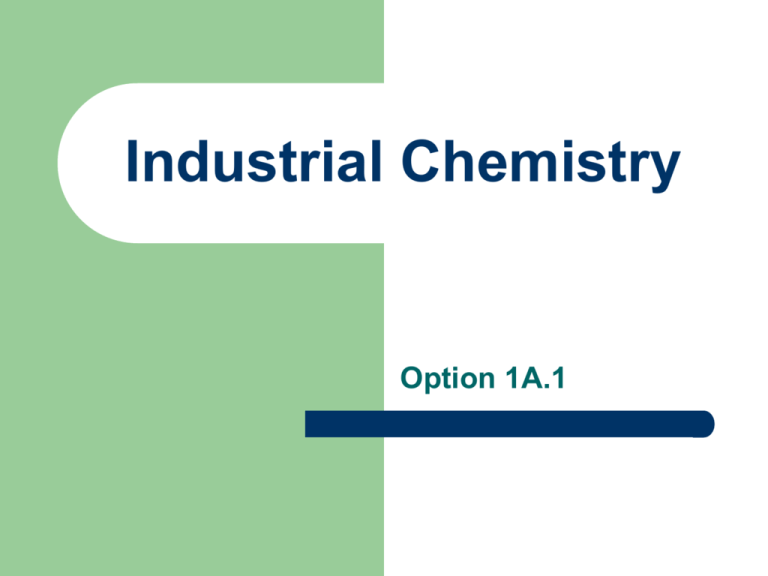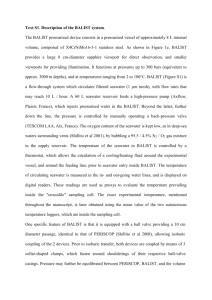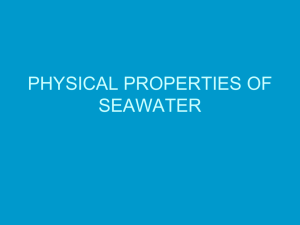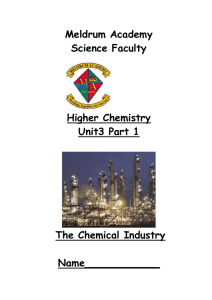File
advertisement

Industrial Chemistry Option 1A.1 Contribution of Chemistry to Society 1. Provides chemicals, pharmaceuticals, fuels, medicines, agrochemicals etc. 2. Provides materials such as plastics, semiconductors, synthetic fibres etc. 3. Provides stable well paid employment and contributes to the knowledge economy. Principles of Industrial Chemistry Batch process: reactants/feedstock are allowed to react for a fixed time with each other inside a vessel known as a batch reactor, under controlled conditions of temperature and pressure. When the reaction is complete the product is isolated. Principles of Industrial Chemistry Continuous process: feedstock continually fed in at one end of the plant and the product is continually removed at the other end. All the case studies are continuous. Principles of Industrial Chemistry Semi-continuous process: is a combination of a batch process and continuous process. The first stage involves a batch process to make the product, and the second stage involves a continuous process where the product is purified using feed from various batch reactors. Batch Process Advantages Disadvantages 1. Low capital costs 1. Time consuming and labour intensive 2. Same vessel used 2. Contamination more likely 3. Easier to cater for slow 3. Difficult to control reactions exothermic reactions Continuous Process Advantages Disadvantages 1. Low labour costs due to computer automation 1. High capital costs 2. Low risk of contamination 2. Less flexibility as plant is since only one product is tailor-made for a specific product being made 3. Long periods of use without stopping for maintenance 3. Not cost effective unless run at full capacity Characteristics of an Industrial Chemical Process Raw materials: Limestone from a local quarry and seawater from the Boyne estuary. Feedstock: Calcium hydroxide and purified seawater. The reactants are called feedstock and produced from the raw materials. Reaction Rate The main reaction is fast. MgCl2 + Ca(OH)2 Mg(OH)2 + CaCl2 So to slow the process down for the formation of large crystals the incoming seawater is diluted with spent seawater. The reaction mixture is seeded with Mg(OH)2. A high temperature of 900oC speeds up the loss of water to form MgO. Mg(OH)2 MgO + H2O Products Co-products: are other products made along with the main product – in this case CaCl2. By-products: are products made from side reactions, which reduce the yield of the main product – no by-products in this case. Product yield: 2g MgO from a litre of seawater. Waste disposal and effluent control Dust is removed by electrostatic precipitators. Gases are scrubbed to remove SOx and grit. The used seawater contains Ca(OH)2 which is alkaline and has to be neutralised to reduce the pH. It is then filtered to remove suspended solids before being released back to sea. Quality control Analysis of all reactants and products are carried out at every stage. Acid-base titrations are used and X-ray fluorescence is an instrumentation technique used to test the purity of the MgO crystals. Safety Ongoing health and safety training for staff on site. Personal protective equipment – helmets, boots, goggles, ear plugs and clothing. Costs Fixed costs are those that have to paid regardless of the rate of production of the plant e.g. labour, plant depreciation, repayment of loans etc… Variable costs depend directly on the rate of production of the plant e.g. costs of raw materials, costs of effluent treatment and disposal, distribution costs, plant maintenance, administration etc Costs can be reduced by recycling and using waste gases for heating. Site Location Plentiful supply of seawater from the Boyne estuary. Site located near a local limestone quarry with good road and rail network for easy transport. Highly skilled workforce available. Site had suitable equipment already as it was previously a cement factory. Construction materials Large concrete silos. Kilns and furnaces lined with refractory bricks. Many of the buildings are made of steel with outer cladding. Materials that are un-reactive and resist corrosion are used. The Chemical Industry Case Study 1A.2 Premier Periclase www.premierpericlase.com Premier Periclase Premier Periclase The manufacture of magnesium oxide is carried out by Premier Periclase in Drogheda, Co. Louth. Premier Periclase It is a continuous process. MgO occurs in the mineral periclase. It has a high melting point 2800oC and used to make refractory bricks, which are heat resistant for lining furnaces. The MgO powder is made into pellets and briquettes. Raw materials Limestone CaCO3 Sea water Feedstock Calcium hydroxide Ca(OH)2 Purified seawater Preparation of Raw Materials roasting CaCO3 LIMESTONE CaO + CO2 LIME Preparation of Raw Materials CaO + H20 LIME Ca(OH)2 LIMEWATER Preparation of Raw Materials Seawater is degassed to remove dissolved gases and filtered to remove solids such as sand and silt hence purifying the seawater. Main Reaction Ca(OH)2 + MgCl2 CaCl2 + Mg(OH)2 heat MgO (used to make refractory bricks for lining furnaces)







